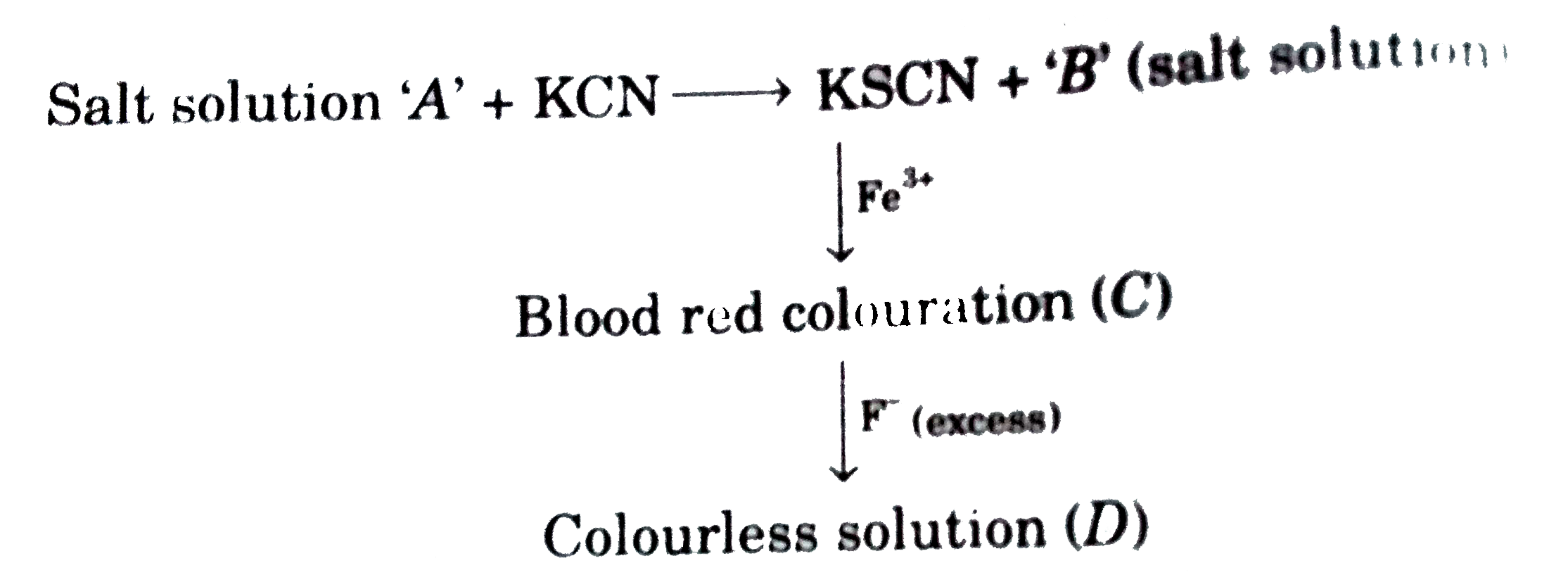What is magnetic moment of complex [Co(CN)6]4−:
The correct Answer is:2
To determine the magnetic moment of the complex (Co(CN)6)4−, we can follow these steps:
Step 1: Determine the oxidation state of cobalt in the complex
The overall charge of the complex is −4. The cyanide ion (CN−) has a charge of −1. Since there are six CN− ligands, their total contribution to the charge is −6.
Let x be the oxidation state of cobalt. The equation can be set up as follows:
x+6(−1)=−4
This simplifies to:
x−6=−4
Solving for x:
x=+2
Thus, the oxidation state of cobalt in (Co(CN)6)4− is +2.
Step 2: Write the electron configuration of cobalt
The atomic number of cobalt (Co) is 27. The electron configuration of neutral cobalt is:
(Ar)3d74s2
For cobalt in the +2 oxidation state, we remove two electrons from the 4s orbital:
Co2+:(Ar)3d7
Step 3: Analyze the electron configuration in the presence of ligands
Cyanide (CN−) is a strong field ligand, which means it will cause pairing of electrons in the d-orbitals. The 3d orbitals split into two sets: T2g and Eg.
- The T2g orbitals can hold 6 electrons (3 pairs).
- The Eg orbitals can hold 4 electrons (2 pairs).
For Co2+ with 7 electrons in the 3d subshell, the filling will be as follows:
1. Fill the T2g orbitals first:
- 6 electrons fill the T2g (3 pairs).
2. The remaining 1 electron will go into one of the Eg orbitals.
Thus, the electron distribution will look like this:
- T2g: 6 electrons (3 pairs)
- Eg: 1 electron (1 unpaired)
Step 4: Count the number of unpaired electrons
From the above distribution, we see that there is 1 unpaired electron in the Eg orbitals.
Step 5: Calculate the magnetic moment
The formula for calculating the magnetic moment (μ) is given by:
μ=√n(n+2)Bohr magneton
where n is the number of unpaired electrons. Here, n=1.
Substituting the value of n:
μ=√1(1+2)=√3Bohr magneton
Calculating this gives:
μ≈1.732Bohr magneton
Final Answer
The magnetic moment of the complex (Co(CN)6)4− is approximately 1.732 Bohr magneton.
---
The overall charge of the complex is −4. The cyanide ion (CN−) has a charge of −1. Since there are six CN− ligands, their total contribution to the charge is −6.
x+6(−1)=−4
This simplifies to:
x−6=−4
Solving for x:
x=+2
Thus, the oxidation state of cobalt in (Co(CN)6)4− is +2.
The atomic number of cobalt (Co) is 27. The electron configuration of neutral cobalt is:
(Ar)3d74s2
For cobalt in the +2 oxidation state, we remove two electrons from the 4s orbital:
Co2+:(Ar)3d7
Cyanide (CN−) is a strong field ligand, which means it will cause pairing of electrons in the d-orbitals. The 3d orbitals split into two sets: T2g and Eg.
- The Eg orbitals can hold 4 electrons (2 pairs).
1. Fill the T2g orbitals first:
- 6 electrons fill the T2g (3 pairs).
2. The remaining 1 electron will go into one of the Eg orbitals.
- T2g: 6 electrons (3 pairs)
- Eg: 1 electron (1 unpaired)
From the above distribution, we see that there is 1 unpaired electron in the Eg orbitals.
The formula for calculating the magnetic moment (μ) is given by:
μ=√n(n+2)Bohr magneton
where n is the number of unpaired electrons. Here, n=1.
μ=√1(1+2)=√3Bohr magneton
Calculating this gives:
μ≈1.732Bohr magneton
The magnetic moment of the complex (Co(CN)6)4− is approximately 1.732 Bohr magneton.
Similar Questions
The spin-only magnetic moment value for the complex [Co(CN)6]4− is ________ BM.
[At. No . Of Co =27]
View SolutionWrite down the IUPAC name for each of the following complexes and indicate the oxidation state, electronic configuration and coordination number. Also give stereochemistry and magnetic moment of the complex :
K4[Mn(CN)6]
View Solution
Knowledge Check

The magnetic moment of complex 'C' is:A1.7B.M.B3.87B.MC2.83B.MD5.92B.MThe magnetic moment of the complex [Ti(H2O)6]3+ is
A3.87BMB1.73BMC2.84BMD5.87BMThe spin-only magnetic moments of [Mn(CN)6]4− and [MnBr4]2− in Bohr Magnetons, respectively, are
A5.92 and 5.92B4.89 and 1.73C1.73 and 5.92D1.73 and 1.73
Write down the IUPAC names of the following complexes and also give stereochemistry and magnetic moment of the complexes :
(i) [Co(NH3)5Cl]CL2
[CrCl3(py)3]
(iii) k4[Mn(CN)6]
(At. Nos. Cr=24, Mn=25, Co=27, py=pyridine)
View SolutionCalculate magnetic moment of Fe3+ in [Fe(CN)6]3+ and in [Fe(H2O)6]3+
Arrange following complexes in decreasing order of magnetic moment
[Ni(H2O)4]2+, [Ni(CN)4]2−,[Fe(CN)6]3−,[Fe(CN)6]4−
View SolutionCalculate magnetic moment of Fe3+ in [Fe(CN)6]3+ and in [Fe(H2O)6]3+
Arrange following complexes in decreasing order of magnetic moment
[Ni(H2O)4]2+, [Ni(CN)4]2−,[Fe(CN)6]3−,[Fe(CN)6]4−
View SolutionAssign the hybridisation, shape and magnetic moment of K2[Cu(CN)4]
View SolutionGeometry, hybridisation and magnetic moment of the ions [Ni(CN)4]2−,[MnBr4]2− and [FeF6]3− respectively are .
View Solution
